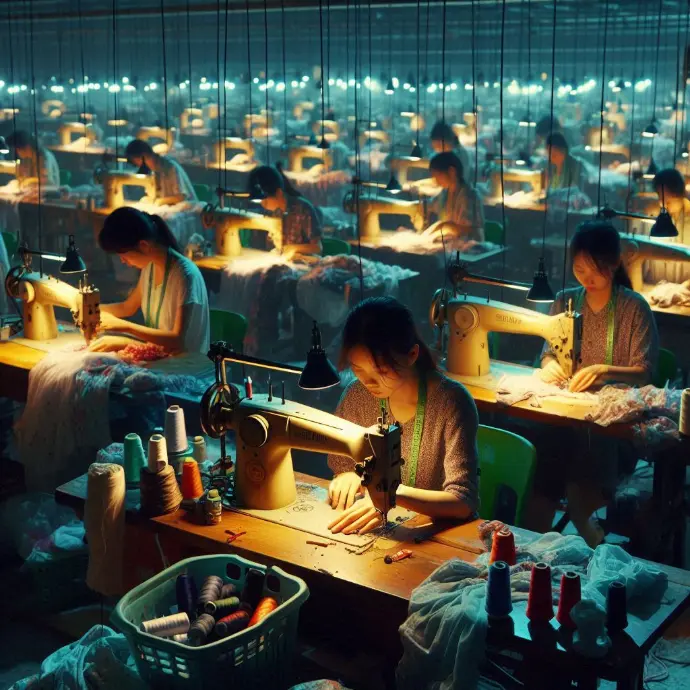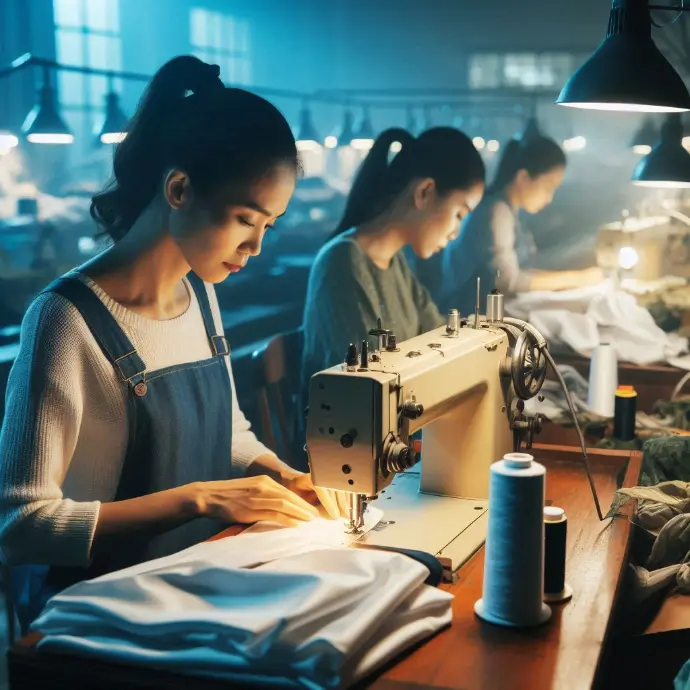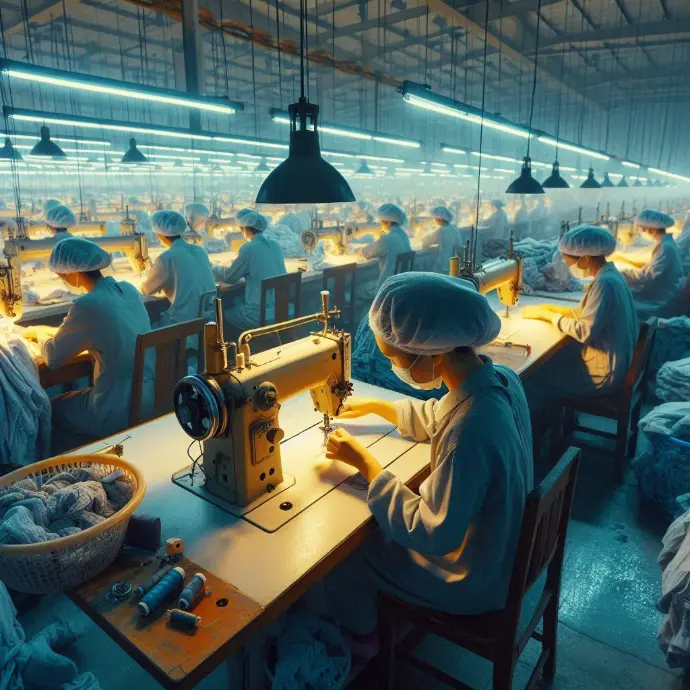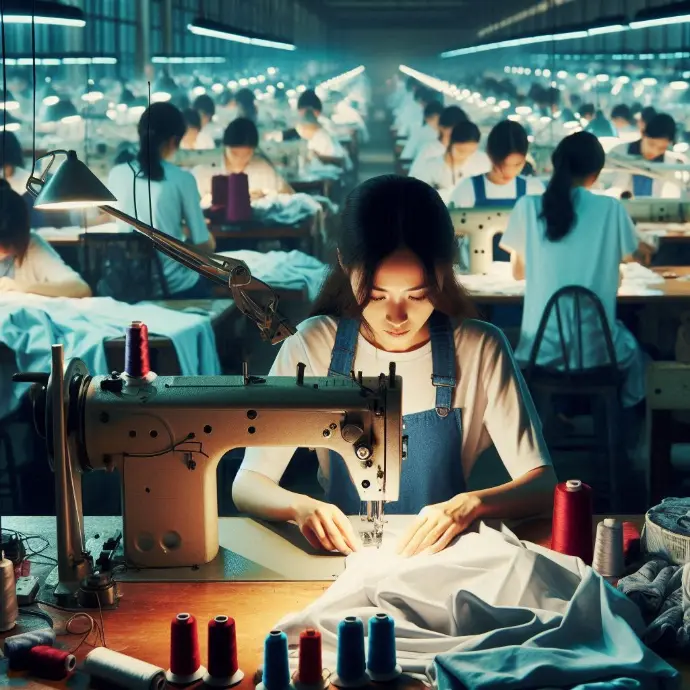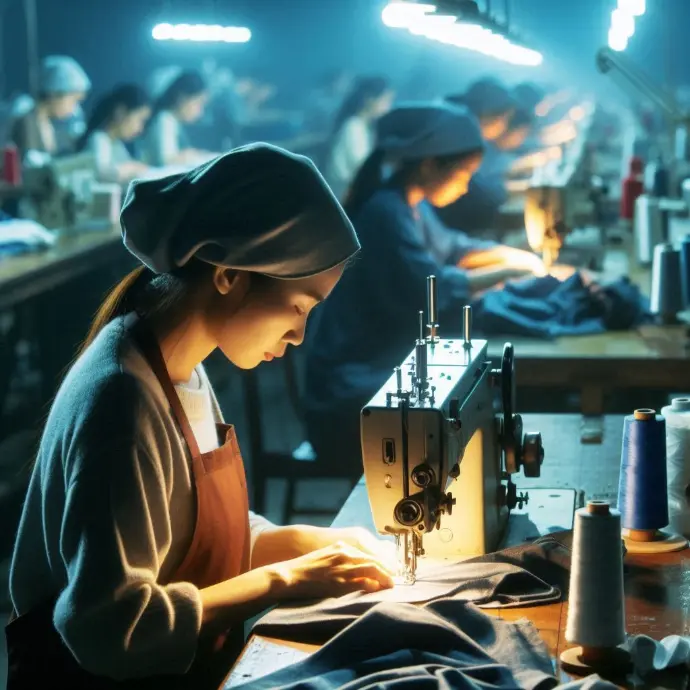In our article "The Impact of Fast Fashion on Women in the Garment Industry," we explore in depth the impact of the fashion industry on women workers. Prepare for an in-depth analysis that will open your eyes to a shocking reality. Are you ready to delve into this fascinating world of exploration and discovery? Join us on this journey of knowledge and influence!

Introduction
The fast fashion industry is characterized by the mass production of garments at an accelerated pace, with a short life cycle and often at a low cost. This approach focuses on rapid production and consumption, leading to constant pressure for companies to launch new collections frequently, which in turn creates an unsustainable demand for labor and resources.
Fast fashion brands often outsource production to developing countries, where labor costs are low. This can lead to precarious working conditions and exploitation of workers, mostly women, who work long hours for unfair wages and in unsafe environments.
The rapid turnover of fashion trends compels garment workers to produce garments at a breakneck pace, often resulting in long working hours and extreme pressure to meet production deadlines.
The social impact of fast fashion extends beyond working conditions, affecting communities and the environment. Mass production and rampant consumption generate a significant amount of textile waste and contribute to water and soil pollution.
Furthermore, the pressure to keep costs low often results in inadequate wages for garment workers, perpetuating the cycle of poverty in many communities. The lack of effective regulations in the fast fashion industry can also exacerbate labor exploitation and undermine workers' rights.
It is crucial to examine in detail how these practices impact women garment workers, as they represent a significant portion of the workforce in this industry and are often disproportionately affected by the negative consequences of fast fashion.
Analyzing the impact of fast fashion on women garment workers is critical to understanding the magnitude of the precarious working conditions they face. This allows for identifying areas for improvement and advocating for more ethical and sustainable practices in the fashion industry.
Furthermore, focusing on the specific impact on women garment workers can highlight the need to protect and promote women's rights in the workplace, addressing issues such as pay equity, workplace safety, and access to fair working conditions.
A thorough analysis of this impact can also serve as a basis for driving meaningful changes in fashion industry policies and practices, fostering a more equitable and sustainable approach that benefits everyone involved in the production chain.
The Influence of Fast Fashion on Women Garment Workers
The fast fashion industry has had a significant impact on the working conditions of women garment workers around the world. In order to meet the demand for low-cost products and accelerated production cycles, many workers face long hours, low wages, and unsafe working environments. In many cases, they are forced to work in precarious conditions, without access to basic safety measures or fundamental labor rights.
Furthermore, women garment workers often face exploitation and abuse, including the lack of formal employment contracts, the imposition of unpaid overtime, and the denial of benefits such as sick leave or vacation time. This labor exploitation has a devastating impact on these women's quality of life, perpetuating a cycle of poverty and vulnerability.
It is crucial to address these challenges and promote decent and safe working conditions for women garment workers in the fast fashion industry. This involves implementing international labor standards, monitoring supply chains, and empowering workers to demand their labor rights fairly and safely.
The impact of fast fashion on garment workers extends beyond working conditions, also affecting their physical and mental health. Long work hours, exposure to toxic chemicals, and constant stress contribute to significant health problems for these women. The lack of adequate safety measures and the pressure to meet production deadlines can lead to physical injuries, burnout, and work-related illnesses.
Furthermore, many garment workers experience high levels of stress, anxiety, and depression as a result of abusive working conditions, job insecurity, and lack of emotional support. The negative impact on these women's mental health is a direct consequence of the exploitation and pressure they face in the fast fashion workplace.
It is critical to recognize and address the significant impact on the physical and mental health of women garment workers and to work collaboratively with industry stakeholders to implement labor practices that protect and promote the comprehensive well-being of these women.
The influence of fast fashion on women garment workers also entails significant socioeconomic challenges. Many of these women face financial insecurity due to low and unstable wages, which hinders their access to healthcare, education, and adequate housing. Furthermore, the lack of professional development opportunities and stagnant wages perpetuate economic inequality and the social marginalization of women garment workers.
These socioeconomic challenges are compounded by entrenched gender discrimination in the industry, which limits women's opportunities for advancement and empowerment in the workplace. It is critical to address these inequalities and work toward the implementation of policies and programs that promote gender equality, economic empowerment, and equitable access to employment opportunities for women garment workers in the fast fashion industry.
The influence of fast fashion on women garment workers poses significant challenges in terms of working conditions, physical and mental health, and socioeconomic inequalities. Addressing these challenges requires a comprehensive approach that recognizes the interconnectedness of these issues and works toward solutions that promote respect, dignity, and the well-being of women garment workers in the fast fashion industry.
The impact of fast fashion on women garment workers has significant implications for women's empowerment and the exercise of labor rights. Women often represent the majority of the workforce in the garment industry, and the accelerated nature of fast fashion can exacerbate gender inequalities and undermine fundamental labor rights.
In many cases, women garment workers face precarious working conditions, low wages, long working hours, and lack of job security. The pressure to produce garments at a breakneck pace leads to further exploitation of workers, which in turn affects their ability to empower themselves economically and enjoy decent working conditions. Women's empowerment is hampered by the lack of autonomy and the violation of labor rights in this context.
It is crucial to promote an empowerment approach that respects and protects the labor rights of women garment workers. This involves promoting gender equality in the workplace, ensuring fair wages, limiting working hours to reasonable levels, and providing a safe and healthy work environment. Female empowerment and respect for labor rights are essential to addressing the challenges faced by women garment workers in the context of fast fashion.
Comparative Analysis in Different Regions
Fast fashion is a global phenomenon that has had a significant impact on women garment workers around the world. Below, we analyze the situation in Asia, Latin America, and European countries to understand how working conditions vary in each region.
In Asia, the textile and garment industry has experienced massive growth due to the demand for fast fashion. This expansion has led to an increase in labor exploitation, with long hours, low wages, and precarious working conditions. Many workers face abuse and discrimination, highlighting the vulnerability of this sector.
Furthermore, in countries such as Bangladesh and India, there have been cases of factory collapses and dangerous working conditions that put the lives of garment workers at risk. Despite efforts to improve working conditions, there is still a long way to go to ensure the safety and well-being of these women.
The pressure to meet production deadlines and low labor costs have perpetuated a cycle of exploitation in the Asian garment industry, underscoring the urgency of addressing this issue globally.
In Latin America, women garment workers also face significant challenges. While the region has seen progress in labor rights, problems such as low wages, lack of social protection, and gender discrimination in the workplace persist.
In countries such as Mexico and El Salvador, women textile workers are affected by long working hours, unsafe conditions, and insufficient wages. They are often forced to meet unrealistic production quotas, which affects their physical and emotional health.
The fight for the rights of women textile workers in Latin America has been a central theme in the human rights movement, and significant efforts have been made to improve working conditions in the region. However, challenges remain that require continued attention and action.
In European countries, women textile workers generally enjoy more favorable working conditions compared to other regions. However, the pressure to remain competitive in the global market has led to the outsourcing of production to countries where precarious working conditions prevail.
Despite progress in protecting labor rights in European countries, the fast fashion industry has posed challenges in terms of supply chain transparency and corporate social responsibility. There are concerns about subcontracting and a lack of oversight in supplier factories, raising questions about the actual conditions of garment workers during production.
It is critical to address the responsibility of fast fashion companies in protecting the rights of garment workers, both nationally and internationally, and to encourage practices that promote a safe and decent working environment at all stages of the supply chain.
Actions and Responses
The impact of fast fashion on women garment workers is an issue that has generated global concern. Labor exploitation, precarious working conditions, and low wages are some of the problems faced by women working in the garment industry.
Government policies and labor regulations play a crucial role in protecting the rights of women garment workers. However, in many countries, these measures are insufficient to guarantee fair and safe working conditions. It is essential that governments implement and enforce laws that protect workers' rights, ensuring decent wages, adequate working hours, and safe working environments. Furthermore, effective oversight is necessary to prevent labor exploitation and sanction companies that violate labor rights.
In this regard, collaboration between governments, international organizations, and civil society is essential to promote and ensure compliance with labor regulations in the garment industry.
As stated by the International Labor Organization (ILO):
Textile workers deserve fair and safe working conditions, and it is the responsibility of governments and companies to ensure respect for their labor rights.
In response to the challenges posed by fast fashion, various companies and organizations have launched initiatives focused on sustainable fashion. These initiatives seek to promote responsible production practices that respect the rights of garment workers and minimize environmental impact. Measures adopted include the use of recycled materials, the implementation of more efficient production processes, and the adoption of ethical standards throughout the supply chain.
Sustainable fashion not only represents an ethical and responsible alternative for consumers, but also has the potential to improve the working conditions of garment workers by promoting fair labor practices and respect for human rights in the fashion industry.
The active participation and organization of garment workers are essential to driving significant change in the industry. Through unions, associations, and social movements, women workers can raise their voices, demand better working conditions, denounce situations of exploitation, and participate in the creation of solutions that benefit the entire working community.
Solidarity among women garment workers, empowerment, and the collective defense of their rights are key aspects to addressing current challenges in the fashion industry. Civil society support and raising awareness about working conditions in garment production are also essential elements to generate positive and sustainable change.
Impact on Global Human Rights
Fast fashion has a significant impact on women's rights, especially in the garment industry. Garment workers, the majority of whom are women, face precarious working conditions, unfair wages, and long hours. Many of these workers are located in developing countries, where labor regulations are less stringent and labor exploitation is more common. This situation directly affects their right to decent work and fair working conditions, demonstrating the need to address this issue from a gender perspective.
Furthermore, gender discrimination in the garment industry is a palpable reality, as women are more likely to experience labor abuse, sexual harassment, and wage discrimination. These situations violate their fundamental rights and highlight the urgency of addressing gender equity in the context of fast fashion. It is crucial to recognize the disproportionate impact this problem has on women and work toward solutions that promote equality in the workplace.
The relationship between fast fashion and women's rights is a crucial issue that requires immediate attention and concrete actions to address the injustices faced by garment workers.
The connection between fast fashion and social justice is undeniable, as precarious working conditions in the garment industry directly affect workers' quality of life. The lack of pay equity, the absence of labor protection measures, and gender discrimination contribute to the perpetuation of social inequality, which in turn negatively affects the health, well-being, and personal development of women working in this sector.
Promoting gender equity and social justice in the fast fashion industry is critical to ensuring that garment workers receive decent treatment, fair wages, and a safe and healthy working environment. This will not only benefit individual women but also contribute to building a more just and equitable society as a whole.
Addressing these issues from a social justice and equity perspective is crucial to mitigating the negative impact of fast fashion on garment workers and promoting meaningful change in the industry.
Stakeholders in the fast fashion industry, including brands, manufacturers, and consumers, have a responsibility to address the negative impact on women's rights. Brands must ensure their supply chains respect labor and gender rights and provide fair working conditions for garment workers.
Manufacturers also have a critical role to play in promoting ethical labor practices and protecting workers' rights. This involves ensuring fair wages, safe working conditions, and implementing policies that prevent gender discrimination and workplace harassment.
Furthermore, consumers play a crucial role in demanding transparency and accountability from fast fashion brands. By making informed purchasing decisions and supporting brands that prioritize garment workers' rights, consumers can influence the industry and promote meaningful change toward more ethical and sustainable practices.
Conclusions
The fast fashion industry has had a significant impact on women garment workers globally. Labor exploitation, unsafe working conditions, and low wages are systemic problems that persist in this industry. It is critical that action be taken to address these injustices and protect the human rights of women garment workers.
The impact of fast fashion on women garment workers is a complex problem that requires urgent attention. Public awareness of these issues is essential to creating meaningful change. Pressure on fashion companies to adopt ethical and sustainable practices is critical to improving working conditions throughout the industry.
A holistic approach is needed that addresses both current working conditions and the underlying causes of exploitation in the fast fashion industry. This problem has no simple solutions, but with collective commitment and concrete actions, progress toward a more equitable future for women garment workers is possible.
Labor exploitation in the fast fashion industry is a reality that continues to affect garment workers around the world.
It is crucial for each of us to reflect on the origin of the clothing we consume and the impact it has on the lives of those who produce it. Being aware of these realities allows us to make informed decisions and support initiatives that promote a fairer and more sustainable fashion industry for all garment workers.


 IHRO NEWS
IHRO NEWS

